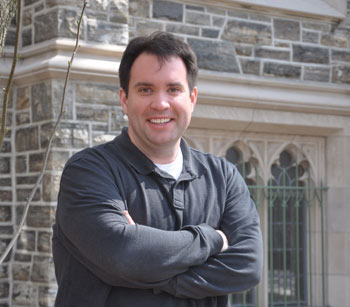
Photo by Janet Sassi
Charles Camosy, Ph.D., is not always politically correct.
In fact, Camosy, assistant professor of theology, is outspoken about hot-button sociopolitical issues: Government embryonic stem cell funding? He is against it. Pulling Terry Schiavo’s feeding tube? He saw cause for it.
“I’m not a conservative, but I’m not a liberal either,” Camosy said. “I think that’s part of what it means to hold Catholicism as more fundamental than an ideological or political affiliation.”
Camosy’s refusal to bow to an ideology nurtures his capacity for viewing moral and theological issues with a fresh eye. He recently received a faculty research grant to explore the public policy implications of some Roman Catholic moral and ethical principles.
His project, “Treatment of Critically Ill Newborns: The Social Quality of Life Model in Light of Catholic Social Teaching,” examines the ethics of withholding or withdrawing life-sustaining treatments for profoundly ill newborns, rather than spending millions on life support systems, therapies and lifelong institutional care. Camosy, who is using his grant to finish a book on the subject, Too Expensive to Treat? Limited Healthcare Resources and the Neonatal ICU for Eerdmans Publishing, admitted that he may be pressing a hot button once again.
A devout Roman Catholic, Camosy said that a case can be made for withholding treatment from profoundly ill newborns by using the church’s distinction between “ordinary” and “extraordinary” treatment. Church teachings require that all means of “ordinary,” or proportionate, treatment must be administered to the sick or dying. But omissions or curtailments of “extraordinary,” or disproportionate, treatments are considered morally and ethically acceptable.
Emotions can run high, he said, when talking about a tiny newborn that is often a “preemie.” What is considered “extraordinary” and what constitutes “disproportionate?” Who decides?
“Nobody wants to talk about this issue,” Camosy said. “Our society has a limited amount of money to spend on health care, and we need to allocate it in ways that will help more people, instead of blindly spending it.
“My first move is to uphold the full moral value of even the sickest newborn babies. They do not count less than any other human life,” said Camosy. But, he said, it also means that they do not count more. Therefore, the disbursal of resources might lead to a situation, given health care constraints, where doctors might have to choose between a 47-year-old diabetic and a 24-week-old baby, he said.
“We mustn’t sweep this problem under the rug by hiding behind easy euphemisms like, ‘You can’t put a price on life,’” he said. “When you have a society that has 50 million people without health insurance, you have to allocate resources fairly. How can society justify spending $30 million on one patient?”
A case in point is Miller v. HCA (1990), involving a Texas woman whose baby was born prematurely. The parents requested that no “extraordinary” medical measures be taken to keep the struggling baby alive, but the hospital intervened against parental wishes. The family sued, and in 1998 received $30 million in compensatory pay to help care for the child for the remainder of her natural life. Now a teenager, the child is profoundly mentally and physically disabled: she has cerebral palsy, does not walk or talk, and is blind and incontinent.
Camosy described himself as most emphatically “pro-life.” But as he sees it, the moral and ethical issue on the table is one of social quality of life (SQL) in Catholic teaching, a model that includes considerations for the just distribution of resources when determining how much treatment to bestow upon a profoundly ill or wounded life no matter what the age.
The SQL standard of intervention, Camosy said, dates to 16th-century Catholic theology, when “omissions” of treatment were allowed for ill or wounded people if such treatment would put too many other lives at risk; for example, a battlefield doctor deciding who best to save.
“There is a difference between killing and letting die. That’s a classic part of Catholic tradition,” he said.
The foundation for SQL, he said, is social teaching that clearly recognizes God’s desire to use the earth’s resources—whether it be energy, health care, food or otherwise—in fair proportion for the common good of humankind.
But, Camosy said, some more extreme religious groups put such a premium on saving a life at all costs that they “make an idol out of biological life, as if it’s the ultimate value for human beings.”
“Any person who sees Jesus Christ dying on a cross knows that there is a higher purpose [beyond biological life],” Camosy said. “If you make an idol out of preserving biological life, isn’t it a violation of the First Commandment, which is, ‘You shall have no other gods but me?’”
In addition to his work on neo-natal ethics, Camosy is working on a book designed to break the impasse between camps with diametrically opposed views on bioethics.
The book, Peter Singer and Christian Ethics: A Conversation, outlines the ways in which some views of Singer, the Ira W. DeCamp Professor of Bioethics at Princeton University, actually overlap with Catholic teachings. Singer is a secular philosopher who believes that abortion and infanticide should be legal and based on certain utilitarian calculations.
Camosy already has written a chapter, “Common Ground on Surgical Abortion? Engaging Peter Singer on the Moral Status of Potential Persons,” for Cambridge University Press. He is about to complete a second chapter that shows the overlap between Singer and Catholic social teaching on duties to the poor.
“People think of Singer on the one hand and John Paul II on the other,” Camosy said. “Differing sides say, ‘Singer is this whacked-out guy who believes in infanticide,’ and ‘John Paul II is that wacked-out guy who thinks we can’t put on a condom.’
“If we constantly engage in stone-throwing, we miss all that we have in common,” Camosy said. “It turns out that the overlap is tremendous. Both sides have a lot to gain by dialogue.”
– Janet Sassi
